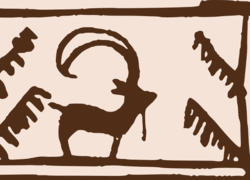History of Iranian animation
The history of Iranian animation, which began in its modern form in the mid 20th century in Iran, can also be traced back to the Bronze Age.
Early history

The history of animation in Iran can be dated back to the Bronze Age. A 5,200 earthenware goblet discovered in Burnt City in Sistan and Baluchestan Province, southeastern Iran, depicts a series of drawings of a goat that jumps toward a tree and eats its leaves.[1] Similar forms of pottery with sequential pictures can also be found throughout medieval Islamic Persia.[2] Such drawings are early examples of precursors to the history of animation.
Modern Day
The art of animation as practiced in modern-day Iran started in the 1950s. Iran's animation owes largely to the animator Noureddin Zarrinkelk, who was instrumental in founding the Institute for Intellectual Development of Children and Young Adults (IIDCYA) in Tehran in collaboration with the late father of Iranian graphics, Morteza Momayez, and other fellow artists like Farshid Mesghali, Ali Akbar Sadeghi, and Arapik Baghdasarian.[3]
- 1970: Duty, First
- 1971: A Playground for Baboush
- 1971: Philipo and a Train from Hong Kong
- 1971: Seven Cities
- 1972: Shower of Flowers
- 1973: Association Of Ideas
- 1973: I Am He Who…
- 1974: Atal-Matal
- 1974: The Castle
- 1975: The Mad, Mad, Mad World
- 1975: The Sun King
Iranian animation has found international reputation. The Iranian animated film The Hole made by Vahid Nasirian and produced by the Experimental and Documentary Film Center was awarded second prize at the 19th Odense International Film Festival, Denmark in 2004.[4]
Tehran International Animation Festival
Tehran International Animation Festival was established in February 1999. The festival was aimed to bring together Iranian and foreign animators and animation films and providing a showcase for unknown potentials of this type of cinema. In 1999, 896 films from Iran and 32 other countries applied for participation in the festival, of which 488 titles were selected for screening during the four days of the event. Other highlights of the first edition of the Festival were special screenings dedicated to commemoration of Feodor Khitrouk (well-known Russian Animator) and Esfandiar Ahmadieh (Father of Iranian animation cinema), who were themselves present in the event, as well as exhibition of animation films of Studio Pannonia of Hungary, ASIFA of South Korea, and works from Czech Republic, Slovakia, Hungary, Yugoslavia and Russia. Retrospectives of works of Bruno Bozzetto and Ali Akbar Sadeghi and screening of student animation films were other sections of the festival. The festival also paid homage to Jean-Luc Xiberras whose name is interwoven with Annecy Festival.[5]
See also
- Iranian cinema
References
- Ball, Ryan (12 March 2008). "Oldest Animation Discovered In Iran". Animation Magazine.
- Baer, Eva (1983), Metalwork in Medieval Islamic Art, State University of New York Press, pp. 58, 86, 143, 151, 176, 201, 226, 243, 292, 304, ISBN 0-87395-602-8
- Press TV - Zarrinkelk, father of Iran animation
- "Iranian Animation Film Wins Second Prize at Danish Film Festival | Dexigner". Archived from the original on 2017-09-30. Retrieved 2016-10-13.
- "Tehran International Animation Festival (1st Festival 1999 )". Archived from the original on 2015-02-05. Retrieved 2007-04-14.